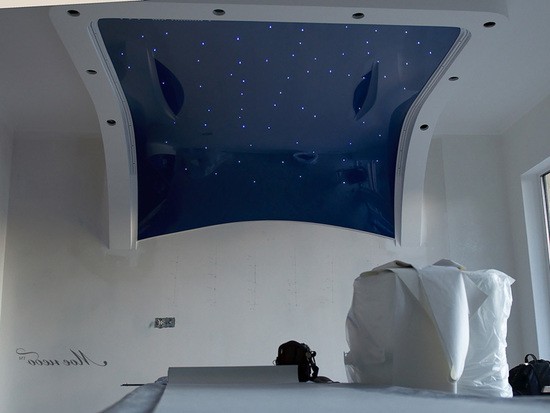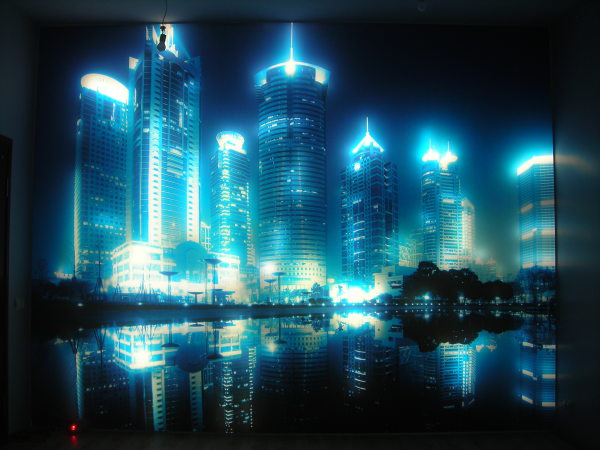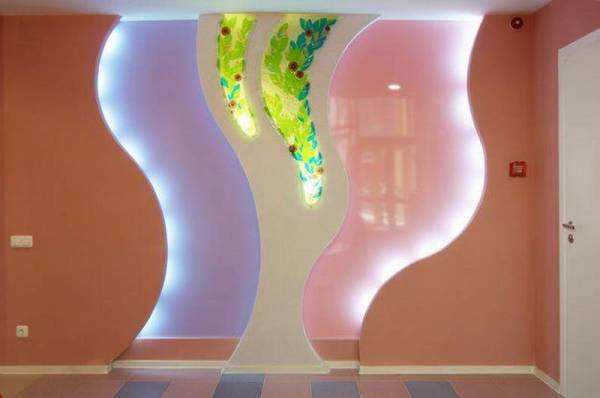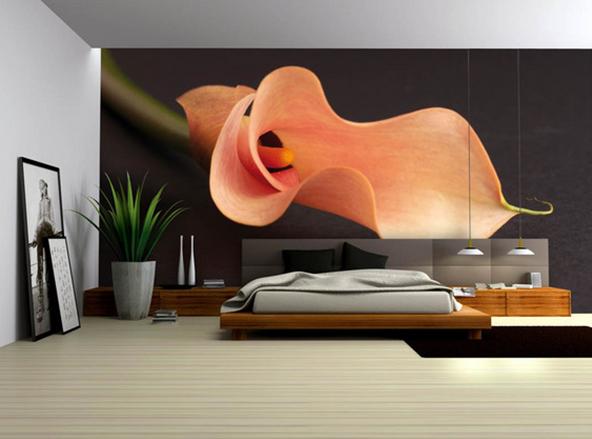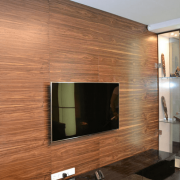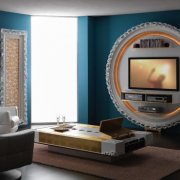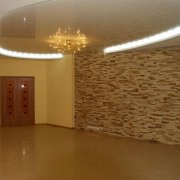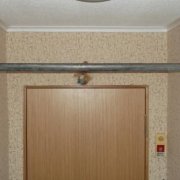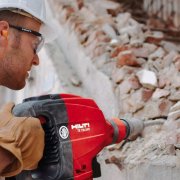Stretch ceiling on the wall: installation features
Stretch ceilings and stretch walls are very close types of decorative finishes. For their implementation, one type of material is used - PVC films, special profiles are used for fastening, their advantages and characteristics are almost the same. How to install a suspended ceiling on a wall, the article will tell.
The content of the article
Features and types of suspended ceilings on the wall
The most popular way to decorate stretch ceilings for walls is photo printing. It has a large number of advantages and design options.
Photos can be completely unique. In addition, photo printing on the wall is easily complemented by illuminations that are installed around the entire perimeter of the tension wall, which allows you to create three-dimensional images, or highlight certain areas of the image, highlighting them in meaning. Because of the picture, no wallpaper will allow a hidden glow.
Stretch ceilings on the wall can be:
- Translucent - This is a very new solution, it is very rare. This technology cannot be repeated with any materials. In this case, the tension wall turns out to be luminous over the entire area. In the design of the room, where there is little light, such a design is indispensable, it allows you to create the illusion of an additional window. In this case, the uniform diffused light traveling along the entire wall resembles a daylight source.
The luminous tension wall, as in the photo, should not be done on the entire wall area, but only partially on one zone, which can be:
- niche (see Niches in the wall: how to make and make it yourself);
- protruding part.
When installing uniform illumination, it is taken into account that there should be free space behind the film, which will take about 10 centimeters of the room area.
Tip: Because of this, such a device should be performed only in fairly large rooms or in suitable niches.
- Rolling into the wall. This is possible when combining the technology of suspended ceilings and walls. The color and texture of the film is chosen so that after installation to obtain a smooth transition from the surface of the ceiling to the wall. The bend inclination and shape can be performed by any suitable for a particular interior.
- In the niches. This design option is better to use:
- in a modern interior;
- in the classic.
At the same time, niches can be decorated with carved wooden frames or metal baguettes.
What are the types of tension walls on the texture
Depending on the texture, suspended ceilings on the wall can be:
- Glossy. In this case, after installation, the stretch webs shimmer and reflect objects, when light enters them. Such a mirror effect allows you to visually push the wall, the room will look more spacious and bright. A colored tension wall can be installed not in the entire area of the wall, but in a niche, which will be much more interesting and spectacular.
- Matte. They are inferior in effect to glossy ones, but they are used for finishing tension walls. Moreover, they are:
- completely matte, made in several pastel shades and white;
- semi-matte and semi-glossy, which are also called satin. Such a wall surface does not have strong reflections, but it will have some iridescent effect.
- Tissue. More often used in combination with photo printing.Until recently, the highest quality photo printing was on fabric textures for stretch linens, despite the high cost, they were quite popular. Now photo printing is excellent at film materials, matte and even glossy, and their price is much lower.
- Art canvas with a picture. On these films, the image is applied at the factory.
Where are tension walls used?
Fastening to the wall of a stretch ceiling is most often performed on well-visible sections of the walls, which will be the center of visual focus in the design of the room.
These can be surfaces:
- Behind the bed.
- In the living room behind the sofa.
- In large niches that have a backlight.
The advantages of tension walls, in comparison with photowall-paper, are:
- No butt welds. There are no seams on the tension walls, and murals are made from several pieces, and upon closer inspection, seams will be visible. In addition, individual parts of the photo wallpaper may not coincide by several millimeters, which is completely excluded in the case of tension walls. On the tension wall, photo printing is one whole image of high quality and without any seams.
- They can be washed.
- No need to putty. Preparing walls for a stretch ceiling does not require such thoroughness as when gluing photo wallpaper. In this case, it is enough to just plaster the wall so that it can be mounted on a stretch canvas. On a brick wall, a stretch ceiling can be stretched over bricks.
Tip: To eliminate cracks in the bricks and improve thermal insulation, a light layer of plaster should be applied to the surface.
- You can mask communications. It is easy to hide all pipes and wires behind such a design (see How to hide wires from the TV on the wall).
- It does not fade, does not change color and does not fade. Service life of materials is up to 30 years.
- All kinds of design options.
The disadvantages of the tension walls include:
- It is impossible to mount them yourself, without the involvement of specialists.
- It is easy to damage the material with sharp objects, and the entire wall will gradually creep away from a scratch, even a slight one, if a cut is not glued with special glue in a timely manner.
How to fix a stretch web to a wall
Before the stretch ceiling is attached to the wall, it is necessary to pay attention to its evenness, which will facilitate the installation process of the structure.
Tip: If it is not possible to straighten even the upper part of the wall, after finishing work, a skirting board should be installed to hide the remaining gaps.
The installation instructions for a regular wall of a stretch ceiling offer:
- Using the building level in the room, the lowest angle is determined, which is designated as zero.
- The necessary indentation is measured.
- A leveling marks the perimeter of the room where baguette fasteners will be installed.
- With ceiling mount, the baguette is mounted tightly to the ceiling.
- The baguette is fastened with screws with special press washers. They are screwed into pre-drilled holes with a pitch of 6 centimeters, and at the joints and joints in the corners - 2 centimeters. A piece of baguette should be at least 15 centimeters.
- The edges of the baguette after trimming are cleaned with fine emery paper, which is previously stretched on a bar.
- The cut surface is degreased.
- The canvas heats up. In this case, the PVC fabric and air are heated to 70 ° C, which will achieve good ductility of the material. Upon completion of the work, a gradual decrease in temperature occurs, and the material begins to contract.
- The canvas is stretched on baguettes and fixed. To do this, one of two options can be used:
- glazing bead. In this case, most often additional ceiling skirtings or some decorative elements are installed.
- harpoon. This method does not require additional improvements.
The choice depends on the baguettes used.
The force of stretch ceilings on the wall is selected sufficient to obtain a high-quality surface, but at the same time the canvas should not break.
- Material and room are left to cool.
Tip: The tension of the canvas on the walls should be done with clean hands.
The installation of the suspended ceiling on the walls of drywall is carried out according to the same technology as on other walls.
Wherein:
- Only the first step should change.
- For fixing baguettes, screws and dowels are not needed, which means that you do not need to drill holes for them.
- Baguettes are glued to drywall on a special glue after thoroughly cleaning it from any impurities and correcting all irregularities on them.
Tip: Before applying the glue, it is necessary to carefully study its properties and act strictly according to the instructions for use. Be sure to glue to dry completely.
The best way to make repairs in the bathroom, ceilings, walls made of stretch fabric and all the features of the work is shown in detail in the video in this article.
Tension walls can be decorated almost any room. PVC film is a dense and very strong material that cannot be damaged by hand or by hitting the ball. And after finishing the room takes on a beautiful and presentable appearance.
